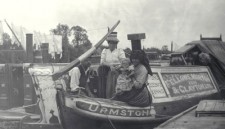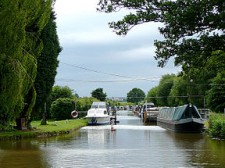-
About Us
Canal Boatmen Family History
Boatmen in the news
Newspapers -Staffordshire
More from Staffordshire
Newspapers - Warwickshire
Newspapers - Birmingham
Newspapers - Leicestershire
Newspapers - Derbyshire
Newspapers - Nottingham
Newspapers - Cheshire
More from Cheshire
Newspapers - Northants
Newspapers - Lancashire
Newspapers - Manchester
Newspapers - Liverpool
Newspapers - Yorkshire
Newspapers - Worcestershire
Newspapers - Gloucestershire
Newspapers - Shropshire
Newspapers - Oxfordshire
Newspapers - Wales
Newspapers - Essex
Newspapers - Kent
Newspapers - London
Censuses
Parish register extracts
Other useful stuff
Contacts, names and photos
Contact
Links
Staffordshire
This is the section of the site which is going to take some time to complete.
However, I would make a few comments. Because boatmen moved around the country on their voyages, even when they had a house on land, newspaper articles about them can turn up in any area where there is a canal. There is often overlap between one area and another, particularly in court cases.
So, as more data is added, it is worth checking all newspapers in all areas - you never know what you might find!

A small selection, this one, dating from 1839 to 1842, but an interesting one. Another "crime" for which boatman could be fined was having a fire and producing smoke in the Harecastle Tunnel!
The major case reported here is the trial and execution of the boatmen accused of the murder of Christina Collins on the Trent and Mersey Canal at Rugeley - probably the most famous canal case of all, because it was used as the basis of the Inspector Morse novel "The Wench is Dead".
Reading the trial details can be confusing unless you already know the details of the case, as two of the boatmen accused had aliases, and both names for each are used interchangeably in the articles.
There were five people on board the "Staffordshire Knot" when the crime took place:
- Christina Collins herself
- James Owen, the captain
- George Thomas alias Dobell
- William Ellis alias Lambert
- and William Musson, the cabin boy
There has been much discussion lately about the doctrine of "Joint Enterprise", a concept which has been enshrined in English Law since 1846, when two cart drivers, Swindell and Osbourne, had a cart race, during which a pedestrian was run down and killed. It could not be proved which cart had struck the pedestrian, but both carters were held jointly liable. Although this case predates this doctrine, it strikes me that a similar decision was taken by the jury here, as it was surely unlikely that all three men drowned Christina Collins, but all of them were involved in the crime, and acted "conjointly" to commit it. The prosecution were unable to prove which man was the guilty party, so all three were held equally liable.
I found the attached record of the case a while ago, and it gives a good overview of it. (Looks an interesting book, this)

Another small but early selection of articles, dating from 1800 to 1847. Luckily, this newspaper covers the aspects of the Christina Collins murder case not covered by the "Staffordshire Gazette" ; the inquest, and the first trial for rape, when the judge decided there was insufficient evidence and therefore no case to answer.
For anyone with ancestors who come from the Black Country, do please take a look at www.blackcountrymuse.com, which is full of interesting information about the area.
Fascinating stuff.
Around 500 articles from the Wolverhampton Chronicle, dates 1830 to 1868. Includes an 1849 description of the sanitary state of Wolverhampton and its surrounds, which puts a whole new slant on the phrase "multiple occupancy". In the same year, there was an outbreak of cholera in the town, when the occupants of Castle Yard were removed to tents on Graiseley Hill to allow their houses to be "purified".
In August 1838, two boatmen, James Holmes and Robert Bromley, were involved in a drunken quarrel, when James Holmes bit off Robert Bromley's lower lip. The lip was exhibited in court - in a tin box!
In 1851, Thomas Day, recorded as an "insane pauper" died in the Workhouse. Questions were asked about the treatment he received, and his body was disinterred and a post mortem carried out. Thomas Day died of erysipelas, which in its later stages can cause disorientation and confusion, and the treatment meted out to him reads like a horror story to our modern ears.
One major set of articles in August 1858 records a train crash at Brettel Lane which killed a Worcester boatman, Henry Marshall.
Some pretty inept rum stealers are recorded in December 1857. They had all drunk so much of their ill gotten gains that they couldn't stand upright, so denial was impossible.
In 1861 the Harrison family were involved in the theft of boat loads of coal from the Lay Colliery in Kingswinford.
A set of articles from 1863 detailing a "conspiracy" in the iron trade is notable for the courtroom exchanges between the prosecutor, Samuel Griffiths, and Mr Kenealy, one of the counsel for the defence, in which the two exchanged insults not normally heard in a court of law.
A small selection from the Dudley Mercury, dates February 1887 to January 1890.
Includes an article from August 1887 recording a Board of Guardians' meeting which shows all the local agencies trying to avoid the responsibility and expense of burying an unknown man found drowned in the canal at Tipton. In October 1889, an accusation of assault by Elizabeth Kent against her husband William sounds more like "six of one, and half a dozen of the other"!

110 articles from the Lichfield Mercury, dating from 1878 to 1900.

A couple of hundred articles from the Tamworth Herald, dated 1870 to 1936. Another offence for which boatmen could be fined was for throwing coal and other materials into the canal, which seemed to be a common practice in Polesworth, near to the Poole Hall Colliery. These articles introduce the delightfully named Horace George Eggleton, a police constable employed by the canal company, who seems to have made a habit of hiding in the bushes by the canal to catch boatmen in the act. Bet he was popular!
The picture is the toll house at Fazeley Junction.
